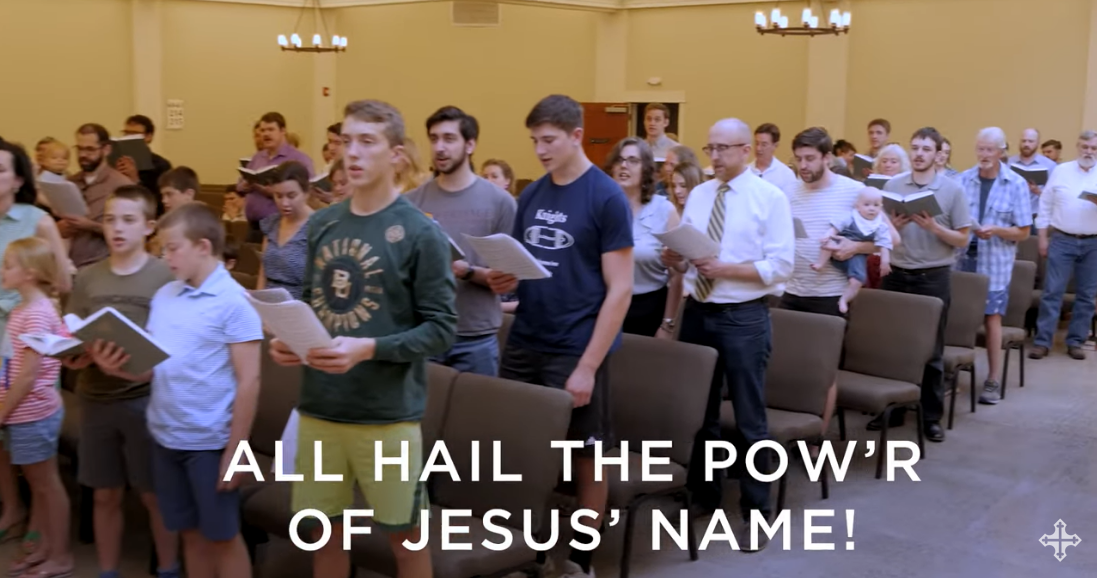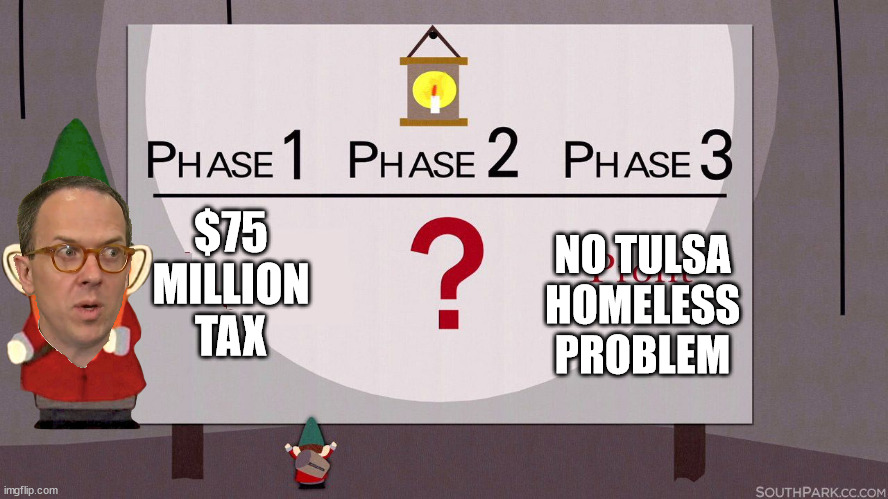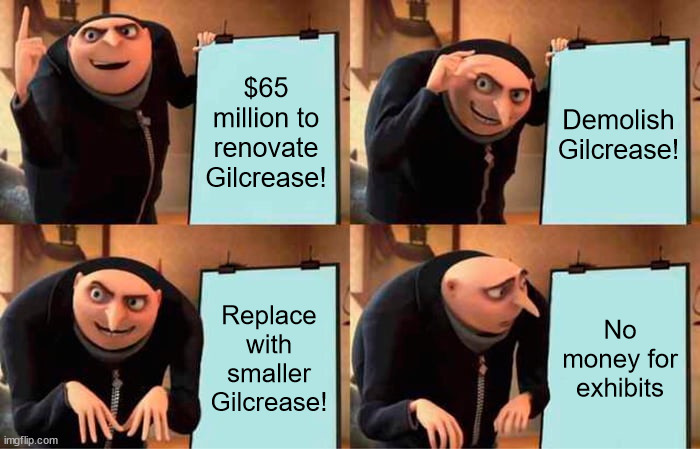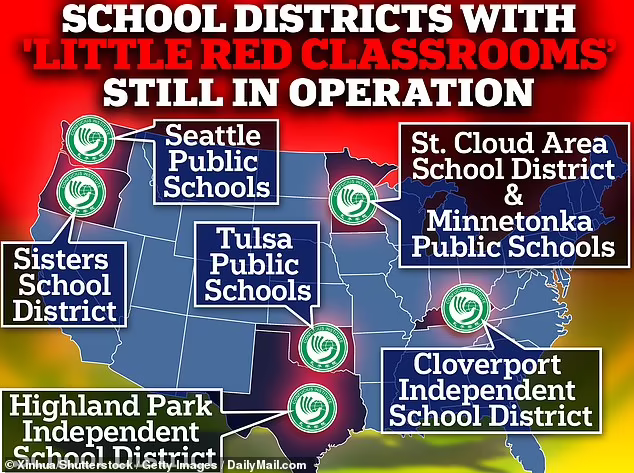August 2023 Archives
 Happy news late this afternoon that Deborah Gist has resigned as superintendent of Tulsa Public Schools. Gist resigns as the state's largest school district faces a hearing on Thursday at the State Board of Education on the loss of its accreditation.
Happy news late this afternoon that Deborah Gist has resigned as superintendent of Tulsa Public Schools. Gist resigns as the state's largest school district faces a hearing on Thursday at the State Board of Education on the loss of its accreditation.
The threat to pull accreditation stems from poor academic performance and lack of financial controls. Alleged embezzlement of nearly $500,000 by Chief Talent and Equity Officer Devin Fletcher and alleged kickbacks to other unnamed employees point to a lack of financial controls and oversight by the Gist administration and the school board majority who have propped her up. Despite the district experiencing year after year of dismal test scores during Gist's tenure, the Tulsa school board majority continued to renew her contract well in advance of its expiration, with some renewals timed such that newly elected board members could not have a vote in the matter.
In a public statement, Gist stated that her handpicked successor would be chosen by the board to continue her work:
There will be a special board meeting on Wednesday evening where the board will consider my separation and the appointment of Dr. Ebony Johnson as interim superintendent. I am enthusiastic about the board's plan to act upon the appointment of our colleague as interim superintendent. As you know, Dr. Johnson is a lifelong Tulsan, a stellar educator, a strong leader, and a remarkable human being. With the leadership of Dr. Johnson, our team will keep the work of our plan on track and will reach even higher.
"The board's plan to act" suggests that a violation of the Oklahoma Open Meeting Act has occurred. Any discussion should occur in a public meeting with adequate public notice. The use of serial private meetings with fewer than a quorum at each in order to avoid an open meeting has itself been found to be a violation of the Open Meeting Act. Board member Jerry Griffin, a critic of Gist, said that he had been kept in the dark:
In light of recent reports surrounding the resignation of Dr. Gist, Superintendent of Tulsa Public Schools, I find it crucial to clarify my position and understanding of the matter. The news surrounding the resignation of Dr. Gist has taken many by surprise, and I wish to expressly state that I too was unaware of the decision until it emerged in the media. Various statements have indicated that this was a decision made by the Tulsa School Board, of which I am a part. However, I was neither consulted nor informed about this decision at any point in time. I must stress that I have not been privy to any discussions regarding the resignation, nor have I been involved in decisions about the interim Superintendent's appointment. These developments have been made without my knowledge or consent.
The Tulsa school board will meet tomorrow, Wednesday, August 23, 2023, at 5:30 p.m., in the Cheryl Selman Room, ground floor, at the Education Service Center, 3027 S. New Haven Ave. From the agenda it appears that the useless board majority intends to give Gist a golden parachute (note item D):
C. Motion, second, discussion and vote on motion to approve a mutual separation agreement with Dr. Deborah Gist as Superintendent of Schools, effective September 15, 2023, at 11:59 p.m.D. Motion, second, discussion and vote on motion to approve amending the district's 403(b) annuity plan to allow nonelective post-employment employer contributions, and authorize the attorneys for the district to prepare/approve the appropriate plan amendment document(s) and the proper officers of the Board of Education to execute the document(s) on behalf of the district.
E. Approve an emergency waiver of the policy suspension procedures in Board Policy 1201 and immediately suspend all requirements under board policies for posting and advertising the position of interim Superintendent of Schools....
G. Motion, second, discussion and vote on motion to appoint Dr. Ebony Johnson as the interim Superintendent of Schools and approve an employment contract with Dr. Johnson to serve as interim superintendent of schools effective September 16, 2023.
The board will go into executive session regarding Gist and Johnson before items C and G, respectively.
For email notifications of new content on BatesLine, subscribe via Substack:
Gist herself indicates that her resignation is meant to appease the State Department of Education and forestall loss of accreditation:
I am confident that my departure will help to keep our democratically-elected leadership and our team in charge of our schools-this week and in the future.
The Oklahoma state school board should not be satisfied that only one head of the hydra has been severed. Gist's departure is happy news, but it's only the beginning of the cleanup effort. All of Gist's cronies, all of the strings-attached foundation grants, the ties to Tulsa's control-freak philanthropocracy, the useless board majority that kept extending her contract and failed to exercise oversight -- they all need to go. State Superintendent Ryan Walters and the State Board of Education should not relent until the cleanup is complete.
It's ridiculous to suggest that we have effective, democratic local control of schools. Oklahoma's school election laws are ideal for thwarting voter involvement -- filing period in early December as families are focused on the end of the fall semester and Christmas, campaigning through the darkest and coldest months of the year so no door-knocking after work during the week, and staggered terms (four years in Tulsa, five years most other places) so voters cannot throw all the bums out in one revolt. Reform of school elections -- I suggest two-year terms and November elections in odd numbered years -- will improve democratic accountability in the long run. In the meantime, when our "local control" has failed to maintain financial control and academic performance, the state has a responsibility to clean house. This happened in 2021 during the administration of State Superintendent Joy Hofmeister, when Western Heights School District in Oklahoma City lost its accreditation after a period of probation.
Only 26 districts in the state scored lower than Tulsa Public Schools in composite academic achievement in 2021-2022, the most recent year for which results have been published. 32 of TPS's 46 elementary schools had 0 students scoring at a proficient or advanced level in the 2021 assessments. Defenders of the TPS status quo claimed that 49 districts have worse performance than TPS, and State Superintendent Ryan Walters should focus his attention elsewhere. But TPS is the largest district in the state, and there are 490 districts that have better performance. The percentage of TPS students at proficient or advanced levels is only 8.86%. Tulsa ranks 18th worst district in percentage of students "below basic" achievement levels at 64.4% -- nearly two-thirds. (Data exported from the SDE interactive data browser is the source of these statistics.)
Earlier this month, Democrat State Rep. Jacob Rosecrants urged that "we need to look past standardized test scores as a way to determine if a school district is failing or not." He claimed that inner-city "student trauma" gets in the way of test performance and the state should respond with "more resources." (Thread captured here.)
If students can't read, they can't read. One-room-schoolhouse teachers -- my great-grandfather was one -- managed to teach poor farm kids -- like my grandfather -- how to read in between fall harvest and spring planting. Public schools in the Depression managed to teach reading, despite plenty of trauma. Self-styled "public education advocates" need to stop making excuses for failed educational philosophies that no amount of money can rescue.
I find it interesting that City of Tulsa and Tulsa Regional Chamber officials continue to speak about TPS as if it were the sole school district of importance. I haven't run the numbers, but I feel certain that there are far more school children living in the City of Tulsa who attend Jenks, Union, Broken Arrow, Bixby, and other public school districts, charter schools, and private schools, or are homeschooled than attend TPS. That's definitely the case for the Tulsa metropolitan region. City officials should tout the wide range of educational options the city has to offer, while treating TPS as a problem to be solved; instead, they defend the fellow insiders who have driven TPS into the ground. If they really are worried about workforce development as they claim, city and chamber officials should demand strong action to clean up TPS.
State Superintendent Walters and the state school board should not be placated by Gist's resignation. I hope that they will act boldly on Thursday to clean up TPS, for the sake of the children who are stuck there and for the district's once-proud legacy. I expect that the System is hoping that sacrificing Gist will allow them to retain control of TPS. (No doubt a very nice sinecure in a non-profit has been set aside for her.) I hope they are mistaken.
Concluding this blog post by switching movie villainesses: Remember, the squashing of the Wicked Witch of the East was at the beginning of The Wizard of Oz. The final defeat of the Wicked Witch of the West and her flying monkeys didn't happen until the end.
Special congratulations go to Tulsa Parents Voice for their research and persistence in documenting Gist's failures, pressing for an audit of TPS finances, and continuing the battle for reform.
MORE: LibsOfTikTok has posted a video by Union Public Schools elementary school librarian Kirby MacKenzie. MacKenzie superimposed this text atop video of herself strutting with an armload of books: "POV: teachers in your state are dropping like flies, but you are *still* just not quite finished pushing your woke agenda at the public school." MacKenzie is also an assistant director at Gaining Ground. KTUL reported that Union Public Schools spokesperson Chris Payne claimed, without evidence, that the video had been "doctored up."
Payne denied, however, that Mackenzie made the video, despite it appearing on her own TikTok page under her name. The video, they said, was edited by a third party and was not Mackenzie's creation."That is the doctored-up version of a video that [Mackenzie] made," Payne told CITC via phone. "They have made changes to her video. What we're talking about isn't even her video, it's one that has been doctored up. Obviously, they have an agenda."
CITC could not identify any differences between the video originally published by Mackenzie on TikTok and the version circulating social media on Tuesday.
When asked for clarification, Payne was unable to identify the "original" video or describe who had allegedly edited it. He also could not explain how the allegedly edited video had been posted to Mackenzie's page without her knowledge or consent.
After a series of emails from CITC attempting to verify the district's claim, Payne said "we are done" and implied CITC was pushing an agenda.
CITC is Crisis in the Classroom, the national education reporting arm of Sinclair Broadcast Group, parent company of KTUL. Their Twitter account, @CITClassroom, provides a feed of stories reported by Sinclair stations across the country on educational failures, predatory teachers, teachers' union activity, pornographic books in school libraries, and the rise of school choice. Recent Oklahoma stories covered a grandparent's claim that Oologah Middle School ran out of cafeteria food and the new school choice tax credit law. Several times they've called attention to their analysis questioning Joe Biden's demand for teacher raises, noting a 43-year long increase in teacher pay (except for the effects of Bidenflation) and plummeting student performance.
This is an encouraging development: A major media chain has noticed widespread parental concerns about public schools and is wisely making it a focus of their local news coverage.

A follow-up to a recent post about Charles Spurgeon's essay on music in worship.
Brian Sauvé, a pastor and hymnwriter, posted recently on Twitter about his church's approach to music in worship:
I get this question enough that it's probably worth posting about it separately:"How do you do music at your church on Sundays?"
Here's the breakdown:
We sing almost exclusively from the Cantus Christi 2020 hymnal, accompanied by a piano. Most of the settings are in four-part harmony.
We don't amplify anything. I conduct the congregation from the front, but don't sing into a microphone. Sometimes I sing the melody, but often I sing the Tenor part.
We sing 10 songs per service. Three of them stay the same each week (David Erb's setting of Psalm 134, The Lord's Prayer, and the Doxology).
The other seven usually consist of about five Psalms and two hymns. These are scattered at different points of the service, including two that we sing seated during the distribution of the bread and wine for Communion.
Why we sing in four parts:
1. It allows men to sing like men, women to sing like women, children to sing like children.
2. It takes effort. We don't want to offer to the Lord that which costs nothing.
3. It is objectively beautiful, far more so than the best contemporary worship band I've ever heard--and we're not even particularly gifted or anything.
4. Much of the great musical inheritance of the Church is in parts. Lose this skill and you lose access to the richness of that blessing.
How we learn to sing songs in parts:
Every Tuesday evening, barring the last Tuesday of the month, we have a potluck followed by a Psalm-singing workshop. I use the "Sing Your Part" app to teach each group their parts, then we practice. The actual practice is only 45 minutes, so the whole thing only takes 90 minutes each week.
We typically have about 50% of our Sunday attendance at Psalm sing on Tuesdays. This lets us learn, on average, one new song per month.
I couldn't even read music when we started learning this stuff. Any church do this if they decide to.
Sauvé offers a video of his congregation singing a setting of Psalm 134 by David Erb, which they sing every Sunday.
Nearly everyone can learn to sing on pitch and to sing a part. St. John's College in Annapolis, Maryland, has a freshman chorus that includes the entire class, many or most of whom have no previous musical experience. Music is one of the Seven Liberal Arts, one of the quadrivium along with geometry, astronomy, arithmetic, and thus a key component of a classical education. By the end of the year, the freshmen have learned to sing Gregorian chant, polyphonic motets, and harmonized spirituals and folk songs, and they perform in a concert.
The unofficial anthem of the college is Palestrina's Sicut Cervus (Psalm 42:1), learned as part of that freshman chorus experience, and every week on Wednesday afternoon, after classes, a little after 2 p.m., any student or tutor available gathers in the Pendulum Pit in Mellon Hall, a stairwell that has a Foucault pendulum, an upright piano, and excellent acoustics, for the "Sicut Sing," a tradition that began in 2012. Sheet music is available for those who need it, but many students manage without. I was able to participate one Wednesday, and it brought me close to tears of joy.
The words translated: "Like as the hart desireth the water-brooks: so longeth my soul after thee, O God." (Coverdale, Book of Common Prayer)
St. John's student Brian Liu wrote about the weekly Sicut Sing:
I have wondered why it has become so beloved at our school. While some may say that it is loved so much simply because it sounds beautiful, I would suggest perhaps a deeper reason. The theme of the piece is man's yearning for God. And though St. John's is a secular institution, that longing - the longing for something more transcendent than ourselves and our longing for communion with it - is the spirit of our institution. It is the spirit of our educational endeavor. We like to think of ourselves as working towards something higher when we read, write and discuss our texts.
In another post, Sauvé lists four essentials of singing together in worship:
Corporate singing should:
- Be singable by men, women, and children. Parts singing helps greatly with this.
- Include the singing of whole Psalms.
- Sound primarily like people singing (not overpowered by instruments).
- Inspire the cultivation of musical skill.
In his thread providing five reasons to learn parts singing at your church, Sauvé writes:
Many modern unison arrangements are too high for the average man to sing. You discourage men in your congregation when you ask them to sing like Bon Iver....Parts singing grants you access to some of the richest treasures left to us by our spiritual forefathers.
It is astonishing the treasures we have.
Our forefathers laid up some potent bottles in the wine cellar that we cannot even open if we won't learn to sing in parts.
If you can only sing songs written in the last 20 years, you are cut off from all of this richness.
You'll have to rely on popularizers to sing dumbed-down and gutted versions of a few of the old songs.
Tomlin might get you a few.
Shane & Shane might get you a few.But if you learn to use the tools, you'll find a whole world of musical glory in the great tradition of Christian Psalmody and hymnody.
While visiting Annapolis, I've often attended Christ Reformed Evangelical Church, which practices the precepts set out above. Their website lists "Singing of psalms and hymns robustly to God" as a distinctive component of their weekly worship service. One Sunday I was there, they introduced a new psalm setting just before the start of the service, playing each part individually and going over a couple of specifically tricky fugue-like passages so that the congregation would be ready to sing it together the following week. They sing at least a half-dozen hymns and psalms each week, singing all the verses at a brisk pace. Four-part music is printed in the service booklet.
MORE: A playlist of congregational singing from the Cantus Christi hymnal. Here is the Christ Church congregation singing "All Hail the Power of Jesus' Name" (tune Diadem):
RELATED: Tony Esolen offers:
Why guitars are generally not good for leading a congregation in song:
- They don't play the melody, while
- their chords turn muddy in a large space, so
- you have to rely on the soloist, so
- he or she needs to be miked up, so
- the congregation is smothered.
Originally posted on August 1, 2023. Post-dating to August 8 so it remains at the top of the page through election day. A previous entry has a just-the-facts discussion of the four August 8 bond issue and sales tax propositions.
Here are seven reasons to vote no on all four City of Tulsa ballot propositions at the special election next Tuesday, August 8, 2023:
1. Two-and-a-half years too early: The proposed sales tax may not go into effect until January 1, 2026.* A lot can change in two years and five months. Economic and global circumstances two years from now may be very different -- just think how different the world was two-and-a-half years ago -- and our priorities may change with those circumstances. We shouldn't commit nearly a billion dollars in spending so far in advance, nor should we start borrowing (and paying interest) on revenue that's two-and-a-half years in the future.
2. Hamstringing the next mayor and council: The proposals block the ability of new city officials to pursue capital improvements to implement their election platforms. A new mayor and city council will be elected in 2024, but the August 8 proposals lock up funding for capital improvements until 2030, after the end of the next mayor's term of office in 2028. It's selfish on the part of lame duck mayor GT Bynum IV, who is not running for re-election, to lock in spending priorities for his successor. There's plenty of time before the current tax runs out for the new mayor and council to decide on a new package. The new officials will have 10 months after taking office in December 2024 to put together a package and put it before the voters.
3. Too vague: $162 million is "itemized" for "citywide" but unspecified lists in broad categories -- streets, sidewalks, alleys, ADA implementation (whatever that means), bridge replacement. This list of vague citywide items includes traffic engineering, which is not a capital improvement but an operational responsibility, and project engineering inspection and testing, which in the past was always priced into individual projects as essential to any construction project. In the original 1980 "third-penny" sales tax vote and its early successors, specific intersections, bridges, widening projects, water and sewer lines, etc., were listed in the sales tax ordinance or general obligation bond issue, committing the city to specific projects with definable costs. It was possible to see whether or not funding was going to the most urgent needs and whether all parts of the city were given due consideration. These vague "citywide" line items don't give the voters anyway of telling whether we're being offered good value for money or whether contractor profits are being padded.
We also don't have specifics on nearly $80 million, divided between Proposition 1 and Proposition 4 for "Additional costs for completion of previously approved street projects listed in Improve Our Tulsa Proposition No 1 approved at an election held on November 12, 2019." Which projects overran? How much does each project require for completion?
Besides the "citywide" and "additional costs" items, many other line items are vague and undefined; some of them are outlined below.
4. $75 million for undefined "housing initiatives": When government sets out to solve a social problem, the money is wasted and the problem gets worse. $22 trillion was spent during the first 50 years of the War on Poverty, and there are more people dependent on government than ever before. The city wants $75 million to solve the homeless problem but they won't tell us how they will spend that money, not even why they think $75 million is the right amount to ask for.
The money will be spent in accordance with the recommendations of the Housing, Homelessness, and Mental Health Task Force, a group of the usual suspects and yacht guests that includes exactly one person who might have some direct experience dealing with homeless people.
The people in charge of our city government and the philanthropocrats** who control them see human beings as mere animals, automata that respond to stimuli in predictable ways. Their thinking goes that if you provide the proper environment and nutrients, people will thrive, just like plants do. That way of thinking leads to the arrogant belief that enough government money can fix anything: "If we can put a man on the moon" -- solve an engineering problem using the unchanging laws of physics and chemistry -- "we can end homelessness" -- a complex set of human tragedies that find their explanation in spiritual truths denied by the philanthropocrats and their minions.
The Founding Fathers and the Framers of the Constitution, informed by a Biblical anthropology, understood that all human beings are created in the image of God and as such have inherent dignity and worth, but also that all human beings are marred by the Fall, and inclined by nature to selfishness and evil, which requires the internal restraint of the Holy Spirit, a conscience externally restrained by the social pressure of a moral society, or, as a last resort, the threat of state violence to prevent violent evil.
Christian ministries like City of Hope Outreach and John 3:16 Mission have helped homeless people successfully leave the streets and rebuild their lives, because they begin with a true understanding of human nature. Materialist philanthropists and social service agencies, no matter how well-intentioned, cannot hope to address the problem and will likely only enable more of the self-destructive and societally destructive behavior they claim to be able to stop, if only they had enough money to spend.
5. Gilcrease Museum held hostage: Bynum IV & Co. are demanding another $7 million in "matching funds for improvements." In 2016, Tulsans approved $65 million to renovate Gilcrease Museum. In 2020, we were told that it had to be demolished and rebuilt. (Bynum IV chief of staff Blake Ewing wrongly claimed at the Tulsa GOP forum that we didn't know until the museum was closed that demolition was necessary. In July 2021, the doors closed for what we were told would be three years. In March 2023 we were told that more money was required, and recently we were told that the museum won't be open to the public until 2026. Bynum IV & Co. will have deprived an entire generation of Tulsa students of the opportunity to visit Gilcrease Museum during their high school years.
Like the proverbial car dealer who throws your keys on the roof and won't get them down until you buy a new car, Tulsa mis-leaders are demanding more money before they'll let us enjoy the priceless collection of artwork, artifacts, and historical documents that we, the Citizens of Tulsa, own. They don't deserve any more trust when they've already betrayed us over and over again. To earn our trust, the first step is to reopen Gilcrease, and put our collection back on display, with the money they already have in hand.
6. PAC in danger: Now City Hall mis-leaders want $55,790,000 for "Tulsa Performing Arts Center - facility renovation, infrastructure, loading dock improvements, safety and ADA improvements." This is more than half of the money for specified projects in Proposition 2. Given our experience with Gilcrease Museum, I would expect a similar bait-and-switch:
- Tulsans approve funding for PAC renovations
- Mis-leaders "discover" "serious problems" requiring demolition (or gutting)
- PAC closes with a promise to reopen in three years
- Mis-leaders "discover" a need for more money to reopen
- Construction delays keep PAC closed for two more years
I believe that Tulsa's mis-leaders wanted a new building for Gilcrease all along***, just like they wanted a new Arkansas River pedestrian bridge, and I strongly suspect they want a new PAC, but they know they cannot convince the voters to approve demolition of a beloved landmark or the full cost of the new facility. So they will deceive Tulsa voters, and if voters are stupid, they will fail to learn anything from past behavior and will let themselves be deceived once again.
Do we want to go for five or more years without a venue for Broadway theater, symphony, ballet, and opera? Until they deliver a new Gilcrease Museum to our satisfaction, we shouldn't trust Tulsa's mis-leaders with another precious cultural institution.
7. Millions more for a toxic lake: Work on the Zink Dam isn't complete yet, and the City wants another $3.5 million (per Proposition 2 in the bond issue resolution) or $5 million (per public statements) for "Zink Lake - infrastructure." Blake Ewing said during the Tulsa GOP forum that this was for parking lots, but when I asked where the document was that spells this out, I didn't get an answer. Meanwhile, Tulsa citizens have unanswered questions about toxic chemicals seeping into the lake from ground water under the refineries, past and present, along the river. Ewing dismissed these concerns as a "political, fun, fun hot button thing to get upset about."
In May 1979, Tulsa voters rejected the first attempt to pass a "third penny" sales tax for capital improvements. The list of projects was too vague, lacked guarantees that money would be spent as promised, and included some big projects that voters didn't want. In October 1980, 60% of Tulsa voters approved a more specific package with better safeguards and without the most objectionable projects. City of Tulsa officials have plenty of time to give us a solid package if we say no to this one.
Thanks to Jesse Rodgers and City Elders for the logo at the top of the page.

A dialogue pertinent to the August 8, 2023, City of Tulsa special election:
"Homeless problem in Tulsa seems worse than ever and all over the city, not just downtown.""Don't worry, GT has a plan."
"What's the plan?"
"$75 million."
"To do what?"
"We don't know yet."
"How do we know it will cost $75 million?"
"We have matching funds and other money totaling $104.2 million."
"That's an awfully precise amount for an undetermined plan."
"Top men will tell us how to spend it. Top. Men."
"When will we find out how it will be spent?"
"After you vote to give us the $75 million."
A friend with experience in this realm says that $75 million could probably fix homelessness (except that some will always choose that way of life) IF it was being used by groups that do things right -- that means working one-on-one and slowly with individuals to address their REAL needs. But it won't.
The city ordinance setting out the policy for spending the sales tax money says it will be spent in accordance with the recommendations of the Housing, Homelessness, and Mental Health Task Force, a group of the usual suspects and yacht guests.
Under the "Improve Our Tulsa 3" plan, my friend notes, the people who will be allocating and spending the $75 million are the same people who stuffed a couple hundred people into a hotel on Garnett for 6 months, indiscriminately. People who lived there reported that drugs, prostitution (including coerced prostitution), rape, and gang activity were rampant. A large number of those residents were eventually housed, but many are back out on the streets, some after two or three trips through the housed/homeless cycle. Every time the non-profits get someone housed, the non-profits get money, so they cycle people through. Landlords let people live out the lease, collect the subsidized checks, then they issue a non-renewal notice the day that lease expires. The people are back out on the streets and back on the wait list for housing after having to reapply. The landlord raises the rental price, and they all repeat the process again. That will burn through the $75 million. A few cheap units might be built, but they'll become havens of drugs and crime and prostitution and trafficking.

$75 million for failed homeless strategies (which they won't disclose before we vote) are on the ballot today, Tuesday, August 8, 2023, part of a special election in the City of Tulsa. Polls are open from 7 a.m. to 7 p.m. Four propositions, three general obligation bond issues and a new 0.95% sales tax, are on the ballot. The Republican Party of Tulsa County has officially come out in opposition to all four propositions, as has independent City Councilor Grant Miller, the only elected official with the courage and wisdom to refuse to send this poorly crafted package to the voters.
Just before 5 p.m. Monday, I received an email from the Tulsa Performing Arts Center, a public trust for the City of Tulsa, urging me to vote yes. I am fairly sure this is illegal, but because it was done at the last minute, any protest or penalty will come too late to undo the effect it was intended to have. The email claims, "As a part of that package, the TPAC would receive nearly $80 million," but the package only includes $55,790,000 for the PAC (Proposition No. 2), and it seems reasonable to fear that the same bait-and-switch that was pulled for Gilcrease will be pulled for the PAC: They'll get this money, then claim they actually have to demolish and rebuild, and then will come back and demand more money and more time; meanwhile Tulsa's orchestral musicians, opera singers, and ballet dancers will be without a place to perform for the next 5 to 10 years. No, thanks. You can read all seven of my reasons to vote NO here.

MORE: For those wondering about the memes on this page: Underpants Gnomes, Gru's Plan.
 The Tulsa County Republican Party has officially come out in opposition to the four City of Tulsa propositions for sales tax and general obligation bonds on the August 8, 2023, ballot ("Improve Our Tulsa 3"):
The Tulsa County Republican Party has officially come out in opposition to the four City of Tulsa propositions for sales tax and general obligation bonds on the August 8, 2023, ballot ("Improve Our Tulsa 3"):
Republican Party of Tulsa County Takes Stance on
Improve Our Tulsa 3 Bond Package
Tulsa GOP is asking voters to Vote No on August 8thTULSA, OK (08/02/2023)
On August 8th, the City of Tulsa is asking all residents to vote on the Improve Our Tulsa 3 bond package. We love Tulsa; however, Improve Our Tulsa is the wrong approach at this time. It is vague and unvetted by the citizens. This package is being rushed when we have over two years to renew the current tax. Our biggest concerns about this package are the $75MM for UNDEFINED housing initiatives in the housing package, additional funding for the Gilcrease Museum, and the uncertainty with Zink Lake. Should this package be passed, the next Mayor will be hamstrung with the responsibility of implementing something he or she had no part in creating. How is this fair for our next Mayor?
We should learn from our history, in May 1979 Tulsa voters rejected the first attempt to pass a "third penny" sales tax for capital improvements. The list of projects was too vague, lacked guarantees that money would be spent as promised, and included some big projects that voters didn't want. In October 1980, 60% of Tulsa voters approved a more specific package with better safeguards and without the most objectionable projects. City of Tulsa officials have plenty of time to give us a solid package if we say no to this one. (batesline.com)
These are just a few reasons why the Republican Party of Tulsa County is asking you, the Tulsa voters, to VOTE NO on ALL FOUR propositions on August 8th because history tells us..... WE. CAN. DO. BETTER.
MORE: District 5 City Councilor Grant Miller explains why he voted against sending the package to the voters:
The mayor continues to dismiss the real and valid concerns of Tulsans claiming that people who don't like the idea of not having a plan for $75M of spending on homelessness or want answers regarding chemicals in the river before spending millions on a recreational area are "...just folks, like Councilor Miller, who object to things for the sake of objecting to them." (Link in comments). We can do better than the Mayor's package and come up with something that actually works for Tulsa, instead. And there is absolutely no reason to rush into this. We have more than enough time to go back to the drawing board according to Chief of Staff, Blake Ewing. Everything is and will be funded through 2025. So why did the Mayor say it would be a disaster?! He knows that's not true. Dismissing Tulsans' very serious concerns is terribly arrogant.
Here's the link to Councilor Miller's comments on KRMG.
Tulsa is the focus of another recent article from a UK newspaper website: A story in the Guardian Online about the impact of expressway construction on Tulsa's Greenwood neighborhood, and the possibility of reviving the neighborhood by removing the north leg of the Inner Dispersal Loop.
Twenty-five years before Don Shaw was born in Greenwood, a white mob invaded the Tulsa neighborhood and killed more than 300 people. Much of the tight-knit community was burned to the ground, including his grandfather's pharmacy.But when Shaw was growing up in the 1950s and 60s, few people wanted to talk about the massacre - perhaps in part because much of the damage was no longer visible.
He remembers walking the streets of Greenwood in his youth and seeing Black-owned businesses up and down its blocks: a hotel, dry cleaner, soul food restaurants, churches, a ballroom, dentists, pharmacies, hardware store, photo studio, the 750-seat Dreamland Theatre. It was an oasis of Black economic self-sufficiency, inside an Oklahoma city flush with oil industry wealth where the Klu [sic] Klux Klan once publicly operated.
"There was a lot of parties," recalled 76-year-old Shaw, who has lived in Greenwood his whole life. "Dances and stuff like that, concerts, lots of stuff going on."...
By December 1921, more than half of the homes that were destroyed had been rebuilt, despite city leaders rewriting zoning and fire codes to prevent the Black neighborhood from surviving. (Some Greenwood locals worked on their homes at night to avoid policemen.) When I-244 came decades later, resistance to the highway was undermined by a lack of Black representation in city government.
The Guardian story was apparently inspired in part by a graphic depiction of the effects of I-244 on the neighborhoods north, northeast, and northwest of downtown Tulsa, produced by New York City architect Adam Paul Susaneck for his @Segregation_by_Design Twitter account. Susaneck got in touch with me back in early June, looking for aerial photos and other information that would help him with a then-and-now visualization of the sort that he has done for many other cities, part of a long-term project (segregationbydesign.com) to depict vividly the destruction wrought by Federal highway and urban renewal funding.
Using historic aerial photography, this ongoing project aims to document the destruction of communities of color due to red-lining, "urban renewal," and freeway construction. Through a series of stark aerial before-and-after comparisons, figure-ground diagrams, and demographic data, this project will reveal the extent to which the American city was methodically hollowed out based on race. The project will cover the roughly 180 municipalities which received federal funding from the 1956 Federal Highway Act, which created the interstate highway system.Since the creation of the Interstate, freeway planning has been an integral tool in the systematic, government-led segregation of American cities. Used not only as a direct means to destroy the communities in their paths, freeways have also been used to cement racial segregation and ensure its endurance. Working synergistically with the legacy of redlining, freeway planning became the ultimate enforcement mechanism: literal walls of concrete and smog that separated black communities from white. In the name of the thinly veiled racist policies of "urban renewal," the freeways took the red lines off the map and built them in the physical world.
Here is the minute-and-a-half video on Tulsa, Greenwood, and I-244:
Greenwood, Tulsa--the famous "Black Wall Street"--before and after highway construction and "urban renewal."
— Segregation_by_Design (@SegByDesign) July 19, 2023
"Decades after the Tulsa Race Massacre [in 1921], urban 'renewal' [in the 1960s] sparked Black Wall Street's second destruction," writes @SmithsonianMag. pic.twitter.com/Qz099Ww1nt
After a street scene from circa 1949, looking north on Greenwood from just north of Vernon AME Church, the video shows the same location today, with homes and shops replaced by today's empty OSU-Tulsa parking lots. The view shifts to a 1951 aerial, zooming in to Admiral Blvd and 1st Street, just west of Utica Ave. The view pans west, as a modern aerial photo replaces the 1951 aerial, showing not only the destruction in the immediate path of the expressway, but the erosion of neighborhoods bordering the expressway, with homes and churches and schools replaced by parking lots and industrial buildings.
At about 27 seconds in, we see an outline showing the boundary of the Greenwood District, and we see I-244 take out two-thirds of what had been a densely-developed business block between Greenwood, Hartford, Archer, and Cameron, and then another business block between Brady, Cameron, Greenwood, and Frankfort. Continuing west, the highway took out more homes and businesses in Greenwood and in the adjacent neighborhood west of Detroit Ave that I've called the Near Northside. A wider swath was cut to build the Cincinnati-Detroit interchange with I-244, and Cincinnati, which had stopped north of Standpipe Hill, now cut through it.
At 41 seconds, I-244 crosses Main Street, sparing Cain's Ballroom. A few seconds later, the massive northwest IDL interchange, connecting the Tisdale Expressway, the Keystone Expressway, and the west leg of the IDL (I-244) wipes out a working-class white neighborhood and cuts downtown off from Owen Park and Crosbie Heights. Edison Junior High gets cleared for the Keystone Expressway at 54 seconds, and then more destruction along the southern edge of the Owen Park neighborhood. When the expressway reaches Yukon Ave, the view zooms out to show a modern aerial view, with the expressways that ring downtown highlighted in yellow, and then the same view from 1951.
The devastation caused by the expressway was significant, particularly to the area known as Deep Greenwood, the commercial district centered on Archer and Greenwood. A May 4, 1967, Tulsa Tribune story, republished here on BatesLine, An Old Tulsa Street Is Slowly Dying, had a photo of the demolition of the Dreamland Theater (at the time, an Elks Lodge) and comments from merchants who were being displaced by the expressway.
The Guardian article discusses the $1.6 million FY22 Reconnecting Communities grant received by the North Peoria Church of Christ, for "I-244 Partial Removal Study." They hope to place the reclaimed land in a trust, to reconnect the street grid, and to avoid gentrification.
But the Grauniad story and the I-244 removal effort misses an important factor in the second demise of Greenwood. The damage done by the expressway was compounded by the "Model Cities" program, the new, Federally funded and allegedly humane approach to urban renewal. It, too, was adopted in 1967, the same year that the path of the expressway was cleared through the neighborhood. The aerial photo from September 10, 1967, suggests that had the expressway been the only insult suffered by the Greenwood District, it might have survived, but Model Cities cleared out everything except the churches and the little remnant of the commercial district south of I-244. Even the original Booker T. Washington High School building, which had survived the 1921 massacre (the L-shaped complex in the upper left of the photo below) was demolished in 1983 in the name of "renewal."
Tulsa Public Schools made the Mail Online on July 30, 2023, as one of 7 school districts in the US with active contracts for Confucius Classrooms, a propaganda outreach of the Chinese Communist Party.
China is funding America's public schools to the tune of $17 million dollars, it has been revealed, with Republicans now probing the disturbing donations.The report by Parents Defending Education states that the close coordination between the Chinese Communist Party (CCP) and U.S. schools to establish Confucius Classrooms has historically included 143 school districts in 34 states and Washington, D.C.
In addition, at least seven contracts are still active in Texas, Kentucky, Minnesota, Oklahoma, Oregon and Washington.
A year ago, July 2022, BatesLine reported on the Tulsa Public Schools board vote on accepting a Confucius Classroom grant for Booker T. Washington High School, the ninth year of the program. The grant had been hidden in a "consent agenda," a long list of items to be approved en masse without discussion or debate, but because three of the six board members present voted against the agenda, several items were brought back individually for consideration at a later meeting. Only one board member, newly elected District 4 member E'Lena Ashley, had the courage and wisdom to vote against accepting the grant and contract "with International Leadership of Texas, in partnership with Confucius Classroom Coordination Offices."
This map ran with the Daily Mail's story:
The story cites PDE's recent report, "Little Red Classrooms," and quotes several Members of Congress concerned by the findings:
Rep. Jim Banks is demanding the Education Department take action with 'urgency' in in order to terminate these 'disturbing' partnerships, he says in a letter to Sec. Miguel Cardona on Wednesday obtained by DailyMail.com.'The Chinese Communist Party is not a trustworthy partner. Accepting funding and influence from our greatest adversary is a threat to America's children and national security,' Banks told DailyMail.com.
He wrote in the letter that the U.S. must 'take every measure' to strengthen its defenses against China including by 'blocking their ability to propagandize in America's K-12 schools.'...
PDE's "Little Red Classrooms" report also mentions Tulsa's "Carver Middle School... which became a "Confucius School" through Hanban&emdash;the subdivision of the Chinese Ministry of Education that, until 2021, operated Confucius Institutes and Classrooms. (This is mentioned on the Carver website under the Global Awareness tab and has beencaptured by the Internet Archive's Wayback Machine.)
PDE discusses the use of third-party organizations to mask the funding ties to the Chinese Communist Party:
Other districts mask Chinese government funding through third-party nonprofit entities. Such is the case in schools in Oklahoma, Texas, and North Carolina.Take the International Leadership of Texas Global, for example--a nonprofit organization that has taken on being an administration apparatus and passthrough for the continuation of the Confucius Classroom programming. Tulsa Public Schools' Board of Education has a contract with the Confucius Classroom Coordination Offices through the International Leadership of Texas Global. Highland Park Independent School District in Texas also received funding from the International Leadership of Texas Global to facilitate its "Chinese core curriculum."
As BatesLine reported last year, International Leadership of Texas operates a network of 22 charter schools, with four more campuses currently in development, plus 4 affiliated private high schools. Recent news items on their website indicate that alignment with China and its Communist government is a high priority for the organization, and also reinforce concerns raised by PDE about Chinese Communist influence over Junior Reserve Officer Training Corps Programs at Confucius Classroom schools:
- First and Only ILTexas Student Thrives in Chinese Flagship Program: A student ILTexas Katy-Westpark High School is the "first and only ILTexas student to attend the university's Flagship Program within its Intensive Chinese Program in the Summer Language Institute. Her accomplishments are so impressive, Ole Miss has offered to pay for the dual credit opportunity this Fall."
- ILTexas Opens New State-of-the-Art Marine Corps JROTC Facility: "ILTexas has the highest Marine Corps JROTC enrollment percentage of any high school in the country where MCJROTC enrollment is optional. An ILTexas cadet spoke at the ceremony, stating the new facility 'will be the center of gravity for cadets to learn leadership, develop their character, and become the best versions of themselves.'"
- Ole Miss Sees Record Number of Students for Chinese Program, Most from ILTexas: "The University of Mississippi (Ole Miss) welcomed 74 high school students for its Summer Language Institute, and reports in a University news article that the Intensive Chinese Program drew a record number of rising juniors and seniors. 69 of the 74 students who attended the summer program are ILTexas students.... International Leadership of Texas' mission is to prepare students for exceptional leadership roles in the international community. The United States declares Chinese as a critical language, recognizing it as a National Security Language. Therefore, all ILTexas students master Mandarin Chinese as part of the core curriculum."
- Summer Camp Highlights Cybersecurity, Language and Leadership for ILTexas Students: "In addition to Cybersecurity and Leadership, students also practiced their Mandarin Chinese during the summer camp, as it's a National Security Language. All ILTexas students take Chinese language classes during the regular school year with the goal of mastering the language by graduation."
- "This is the closest thing to actually going to China:" ILTexas Students Dive Into the Chinese Culture at the University of Mississippi : "ILTexas is proud to partner with the University of Mississippi (Ole Miss) to allow our students to take part in a complete Chinese cultural immersion experience.... Chinese is recognized as a National Security Language, and is a pillar of the ILTexas core curriculum. "
- Chinese Ambassador Qin Gang Visits ILTexas : "International Leadership of Texas teachers and staff filled the gym of ILTexas Garland High School on Tuesday, May 31, to welcome the Chinese Ambassador to the United States Qin Gang. A special luncheon was held in the school library for the Ambassador and ILTexas leadership. The luncheon was followed by a ceremony where ILTexas teachers, students, and headquarter staff honored the Ambassador's visit. Senator Royce West and his wife, Carol West were also in attendance."
At the July 10, 2023, Tulsa school board meeting, renewal of the Confucius Classroom agreement was once again included in the "Consent Agenda," a list of 33 items to be approved as a group by the school board without debate, as item E.7.:
RECOMMENDATION: Renew the agreement for the Confucius Classroom Coordination Offices through the International Leadership of Texas, a 501c3 organization, an international partnership dedicated to building the field of Chinese language teachers and Chinese language learning in American schools for the 2023-2024 school year.FURTHER RECOMMEND:
The attorneys for the school district approve the appropriate contract document(s) and the proper officers of the Board of Education be authorized to execute the document(s) on behalf of the district.COST: No cost to the district
FUND NAME/ACCOUNT: Confucius Classroom 81-2273-1000-000000-000-07-735
RATIONALE:
This will be Booker T. Washington's fourteenth year to participate in a Confucius Classroom program. International Leadership Texas, in partnership with the CCCO, offers a quality program which will allow our students to continue in the study of the Chinese language.
Note that last year's agenda claimed that 2022-2023 would be the ninth year, but this year's agenda claims that 2023-2024 is the 14th year of the program at Booker T. Washington High School. Once again, E'Lena Ashley was the only board member to vote against the contract.
Meanwhile, only 27.9% of economically disadvantaged TPS K-5 students and only 25% of Grade 6-8 students are reading at or above the national median student, but TPS administrators feel great about it -- by 2027 they hope that only two-thirds of disadvantaged TPS students will be worse readers than the national median.
MORE: Stream of the July 10, 2023, Tulsa Public Schools Board of Education meeting.


